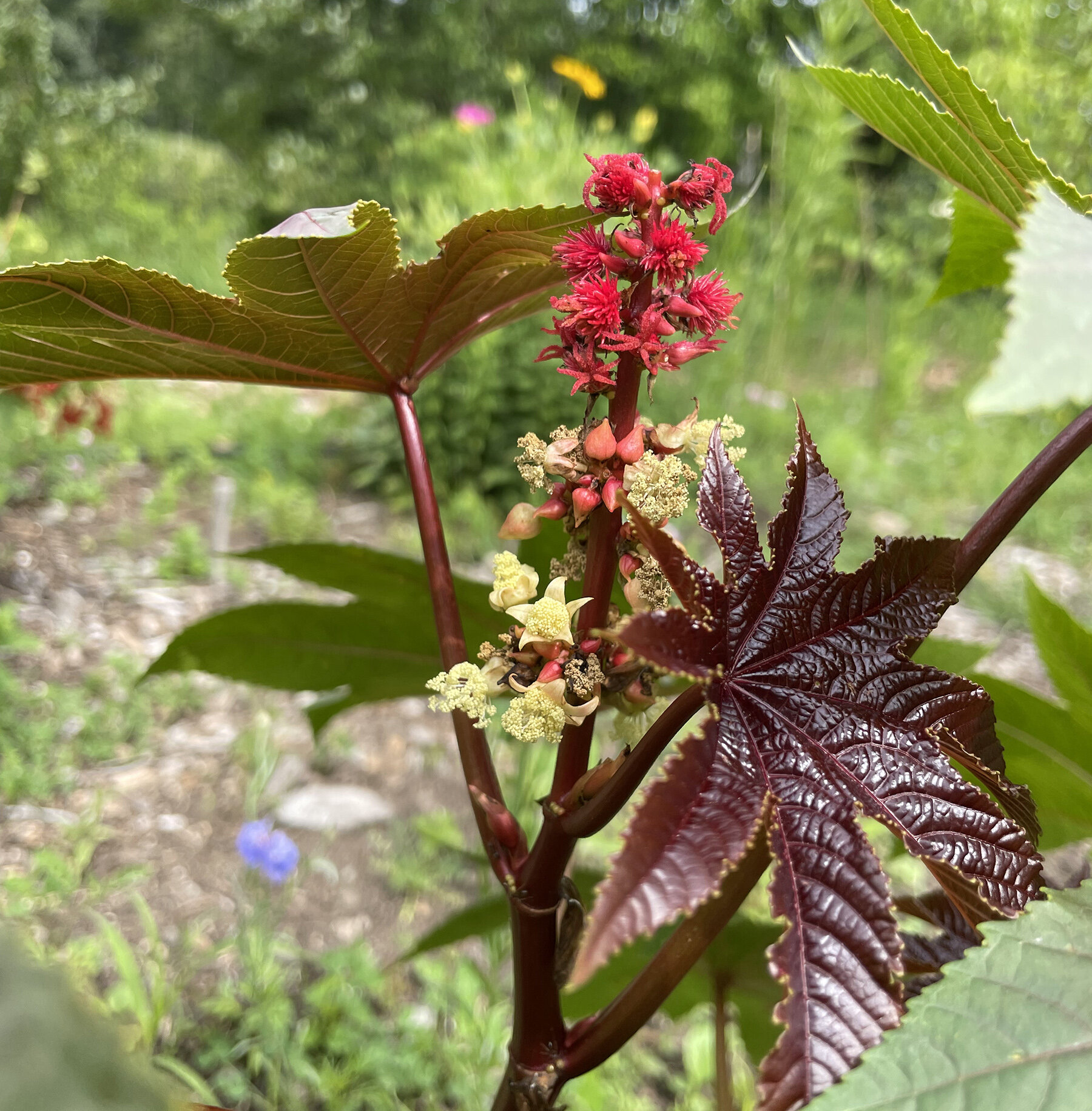Last fall I saved some seeds in a plastic container in our mud room and promptly forgot about them. A week ago, I remembered. I soaked the seeds for two days before planting them in a large clay pot to see if they would germinate. Then I placed the pot on the porch where I would see them and be sure to remember to give them water twice a day. I didn’t want the sprouting beans to dry out. When I returned later that afternoon to water, the pot was gone. That seemed odd. Where did it go?
For the last few years, we’ve grown a singular plant in the garden outside our kitchen door. It’s odd looking, and almost always unfamiliar to visitors to the farm.
“What’s that growing?” we are asked.
“It’s a castor bean plant, Ricinus Communis.”
While it can grow as a perennial tree in temperate climates, here in New England, we grow it outdoors in a sunny spot as an annual. This red-leafed variety grows quickly, in one season easily touching eight feet, and it isn’t finicky about its soil. The plant has very large leaves—you wouldn’t be wrong to think a child-sized umbrella—shaped like a giant Japanese maple leaf with deep lobes. We have been buying one plant each spring from Applefield Farm in Stow each year.
Young Castor Bean Plant with flowers and small seed pods.
The small clusters of pale flowers are barely noticeable, though they have a sweet scent. It’s the seed pods that attract attention. Red clusters of spiky balls, a little smaller than horse chestnuts, vie for room along thick stalks. Then, once the pod dries and the seeds within are mature, the pod splits open, and literarily shoots forth its smooth, oval-shaped, brown-red seeds. I can only guess that since it is self-sowing, the plant doesn’t want too much competition at its roots from its own offspring. And with the seeds protected in their spiky pods, birds aren’t helpful with dispersal. And then, there’s the poison, which I’ll get to soon. But first, let’s solve the mystery of the disappearing pot.
When I saw Blase I asked, “Did you move my pot of castor beans?”
“Oh, I planted a cutting from the Fiddle-leaf Fig in that pot,” he said.
Blase had seen the pot sitting in the corner of the porch, and in need of a pot, he took it, plunging the fig cutting into the center, and setting it on the plant bench in the sun room. He had no way of knowing it was filled with castor beans.
A week later, the castor bean seeds began to germinate. Thick pink bean stalks poked out from the now white lima-bean-size seeds. I dug the seedlings out from around the fig and planted them in individual pots.
And what about the poison? Well, yes. The plant is considered poisonous because the seeds contain ricin, a serious toxin, especially when injected into the body. Eating enough raw seeds will also make you ill with diarrhea and vomiting. The gritty facts about how it is used as a poison can be found here. Earlier this year a man who worked for a biotech company in Massachusetts was arrested for buying 800 castor beans with the intention of extracting the poison. I didn’t know anything about the dark side of castor beans before writing this blog.
And what about the oil? The oil is not poisonous. It is most often sold as a laxative, but it has lots of other uses: lamp oil, soap, candles, plastics, linoleum, paints, inks, ointments and coolants. The seeds contain close to fifty percent of their weight in oil. When I was waiting for the birth of my second child, my midwife told me she was going away so I needed to get this birth moving. She suggested castor oil. It was disgusting. And I don’t think my teaspoonful had any bearing on Nick’s precipitous arrival a day later.
I did learn that in ancient Egypt castor oil was often used for lamps as well as medicinally. Castor bean seeds have been found inside tombs. I can imagine the seeds were buried to keep the lamps lit while the dried apples strung inside the tomb provided food for the deceased’s journey home. I have lots of castor bean plants growing on our side porch. If they do well, I’ll put them out at the farm stand and you too can pick up one of these show-stopping annuals.

